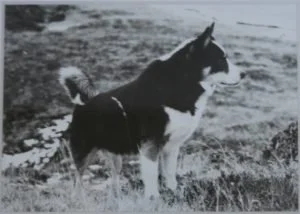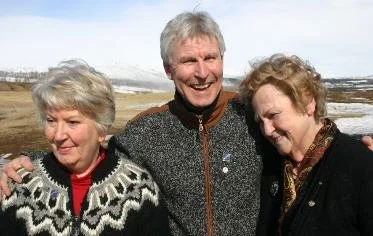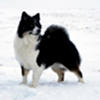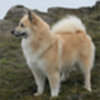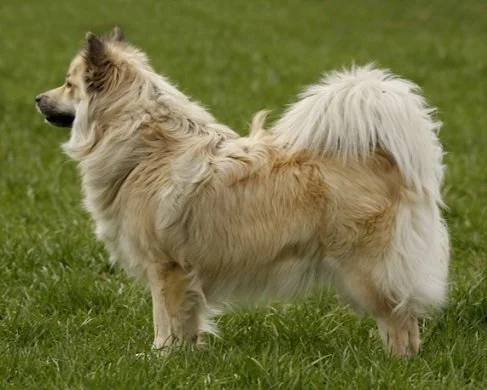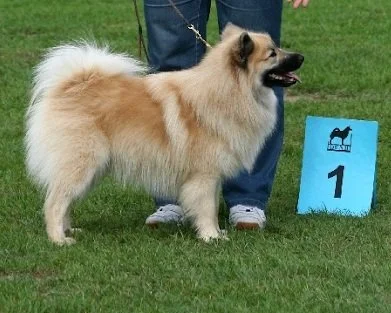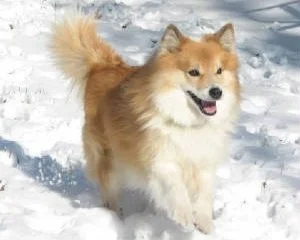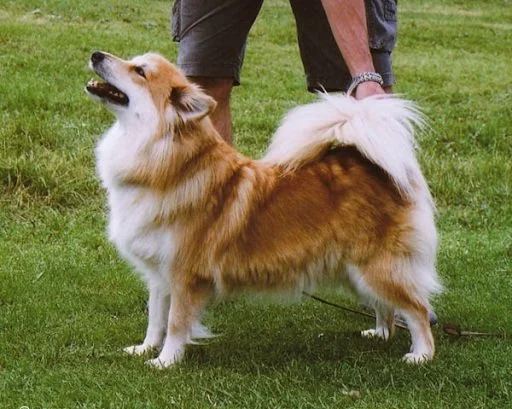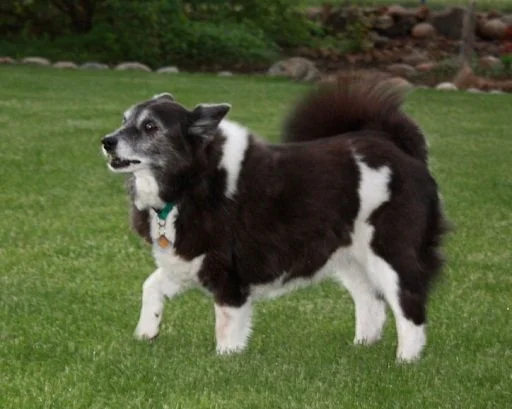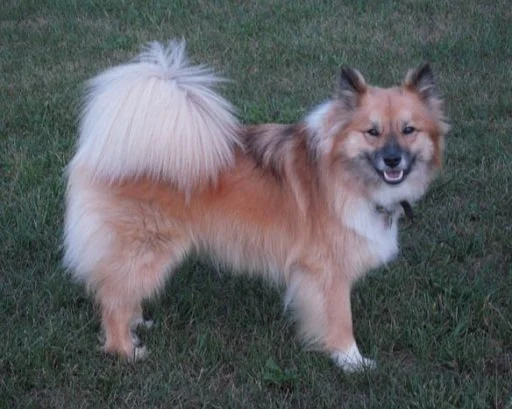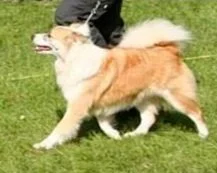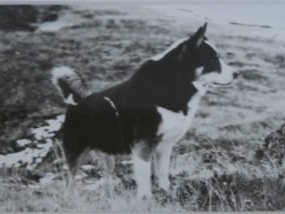
Illustrated Standard
Endorsed By The Icelandic Sheepdog Breed Club, Deild Íslenska Fjárhundsins (DÍF).
~ Dedicated To The Memory Of Iceland’s First Champion ISCH Íslands Garða Tinni ~
Please note: 2021-this document needs revision due to revisions in the FCI standard and subsequent in-progress updates to the 2010 AKC standard. When there is a discrepancy, the language contained in current standards is correct.
Introduction
Welcome to the Icelandic Sheepdog Association of America’s (ISAA) Illustrated Standard of the Icelandic Sheepdog (ISD). This is a tool specifically designed for ISAA members and AKC judges who wish to learn more about the AKC Standard of Excellence for the ISD. It has been reviewed and endorsed by the Icelandic Sheepdog Breed Club, Deild Íslenska Fjárhundsins (DÍF). We hope you find it a useful tool.
To get started, please utilize the buttons below, beginning with a complete copy of the AKC Breed Standard. Following that, you will find a button that will take you to a section regarding the history of the breed, and then the standard is broken into sections, beginning with General Appearance, etc.
Each button contains the specific pertinent section taken from the AKC Standard, followed by the FCI Standard with Comments from Hans-Åke Sperne, photographic examples of ISDs, judges evaluations and drawings (when available). The AKC standard for the ISD is based upon the international standard (FCI) which was developed by the Icelandic Sheepdog Breed Club, Deild Íslenska Fjárhundsins (DÍF). It mirrors the FCI standard almost word for word, so the comments are extremely relevant to our standard.
© Donna R. McDermott. Used with permission.
DÍF has said that three of the experts on the ISD are Guðrún R. Guðjohnsen, Hans-Åke Sperne and Sigríður Pétursdóttir. They are pictured above, left to right. All Evaluations found under photographs are from an expert judge or submitted for inclusion by DÍF. If there is more than one evaluation for any given dog, we have used the evaluation of another expert. All evaluations from FCI/ISIC ISD clubs have been translated from the original language. All photographs utilized are of dogs that placed first, second or third, or the equivalent for an FCI country, under an expert judge as defined by DÍF or were specifically selected by an expert judge or submitted by DÍF. Our intent is to show you good examples of the breed from around the world, as determined by a breed expert or the home country.
We recommend that as a companion to the Illustrated Standard, you also purchase the Icelandic Sheepdog Video. The video is based on the official breed standard for the Icelandic Sheepdog. The breed standard sets down clearly what the dog should look like, its temperament and working ability. For more information, please visit: http://www.hrfi.is/
We would like to thank the Board of Directors of the ISAA for this opportunity, Mari-Beth O’Neill of the AKC, the Icelandic Kennel Club, AKC Judges Pat Putman and Pat Hastings, the Board of Directors of DÍF, for their assistance with our standard and the membership of the ISAA for voting it in overwhelmingly in 2009. We also owe a tremendous debt of gratitude to Helga Andrésdóttir for her original translation of the standard, without which none of this would have been possible, including our work to create a standard that is specifically modeled after the FCI standard written by the country of origin, Iceland.
We would also like to thank the members who shared evaluations and photographs of their dogs from the National. Additionally, we are grateful to our partners from the Icelandic Sheepdog International Cooperation (ISIC) for their generosity of time and resources; specifically, Guðrún R. Guðjohnsen (ISIC/C), Hans-Åke Sperne (ISIC/C), Sigríður Pétursdóttir (DÍF), Ami Rooth (SIFK), Jørgen Metzdorff (DKK), Þorsteinn Thorsteinson (DÍF), Else Westermann (DKK), Susanne Schütte (DCNH), Dorthe Friis Reitzel (DKK), Pia Stämpfli (IHCS), Ulla Sonne (DKK), Monika Karlsdóttir (DÍF), and the many others whose assistance made this project possible.
The ISAA is the first official Icelandic Sheepdog breed club outside the FCI that has been recognized by the ISIC breed clubs as a partner. This partnership has proven invaluable to the process of creating this illustrated standard. If you would like to read more about our international partnership, please visit: About the ISIC Of course, we wish Sir Mark Watson could be present as his dream of full AKC recognition is realized as of June 30, 2010. He and Sigríður Pétursdóttir worked so hard in the beginning to save the breed from extinction and we wish to honor them by not changing the breed, which is Sigríður’s primary concern and request.
We hope you enjoy this information and find it a useful tool as you learn about the ISD. Please direct any questions to isaabod@gmail.com and we will be happy to help in any way possible.
© Brynhildur Inga Einarsdóttir. Used with permission.
General Appearance and Type
Iceland, Best of Breed and Best of Opposite, August 22nd 2009 Judge Sigríður Pétursdóttir
From the AKC Standard
GENERAL APPEARANCE: The Icelandic Sheepdog is a Nordic herding Spitz, slightly under medium sized with prick ears and a curled tail. Seen from the side the dog is rectangular. The expression is gentle, intelligent and happy. A confident and lively bearing is typical for this dog. There are two types of coat, long and short, both thick and extremely weatherproof. There is a marked difference in appearance between the sexes
FCI Standard with Comments
FCI-Standard No. 289/20.06.2007/GB
Translated by Helga Andrésdóttir (IS). Comments originally made by Hans-Åke Sperne (S) are translated by Jørgen Metzdorff (DK)
Origin: Iceland
General appearance: The Icelandic Sheepdog is a Nordic herding spitz, slightly under medium sized with prick ears and a curled tail. Seen from the side the dog is rectangular; the length of the body from the point of shoulder to point of buttock is greater than the height at withers. The depth of the chest is equal to the length of the foreleg.
The expression is gentle, intelligent and happy. A confident and lively bearing is typical for this dog. There are two types of coat, long and short, both thick and extremely weatherproof. There is a marked difference in appearance between the sexes.
COMMENT: The Icelandic Sheepdog is a rectangular dog and must be seen as closer the ground than to the sky – this however, without seeing it as a short-legged dog.
Neither may it be seen as quadratic and/or a high and flimsy. The expression described in the standard, emerge by a filled nose, which is wide at basis – and in the previous breed standard described as “smiling”. This however; must not be mistaken by a dog pulling up its upper lip, showing teeth in such fashion that we [humans] see it as laughing.
The behavior of the Icelandic Sheepdog must be mirrored in the expression, i.e., it must be bright, intelligent, trusting, and gentle.
The entirety, the type, and the constitution, based on the standard of the breed is the primary things to evaluate at the exterior judgment.
Iceland - January, 2008 Judge: Sigríður Pétursdóttir
Judge: Sigríður Pétursdóttir noted: Very beautiful bitch, typical Icelandic with all the charisma, nice expression, good ears, excellent neck, strong back, good bone structure, good ribcage, strong well developed and connected dew claws. Good coat. Excellent.
2009 ISAA National Specialty: BOS
Judge Guðrún R. Guðjohnsen wrote: Coat: Long, pied; Head: Triangular, good expression; Bite/Mouth: Correct; Eyes: Good, dark; Ears: Nice, correct size; Chest: Well-sprung; Front angulation: Good; Back angulation: Good; Topline: Level & Strong; Tail: Correct; Movement: Good
ISAA National 2009
Judge Guðrún R. Guðjohnsen wrote: Coat: medium (short length) fawn-reddish with white markings, Head: good, triangular, Bite/Mouth: correct, Eyes: beautiful, brown eyes, Ears: [a] tiny bit too big, Chest: good, Front angulation: good, Back angulation: good, Top Line: level, Tail: Correct, Movement: Moves well.
May, 2008 DKK Show
Judge Hans-Åke Sperne wrote: CHAMPION CLASS BITCH; EXCELLENT
Small bitch with very good proportions. Very feminine head with a very nice expression and a very nice look. Could have stronger ears. Fine neck. Well shaped chest, which could have been longer instead of the long lower back. Very well placed and well carried tail. Matching legs. Double dew claws. Dense but open coat. Narrow but good leg movements. Well presented.
2009 ISAA National
Judge Guðrún R. Guðjohnsen wrote: Coat: long. Light fawn with black mask and black tips, Head: good expression, Bite/Mouth: correct, Eyes: dark, Ears: correct, Chest: good, Front: good, Back: good, Topline: correct, Tail: correct, Movement: good.
SIFK’s Special Show in Borås 1 July 2007
Judge Sigríður Pétursdóttir wrote 42.5 cm tall (16.73 in). Female bitch with beautiful expression. Good ears. Good and well set neck. Stabile body. Good bones. Wish better angles in front and rear, but moves otherwise rather well. Double dew claw one side, grown together on the other side. Good fur quality.
ISAA National 2009. © Brynja Tomer
Judge Guðrún R. Guðjohnsen wrote: Overall: very good; Coat: long coat, fawn with white markings and black mask; Head: beautiful head and expression; Bite/Mouth: correct; Eyes: good; Ears: excellent; Chest: good for age; Angulation: Both back and front good; Topline: strong and level; Tail: correct; Movement: excellent.
Iceland. © Brynhildur Inga
Judge Guðrún R. Guðjohnsen wrote: Male dog (right) of a very good type. Head pretty good, good ears, very dignified and handsome, good [top line], tail excellent, good bones, movement very light and good, good quality of coat - short haired, single dew claws.
SIFK’s Special Show in Borås 1 July 2007
Judge Sigríður Pétursdóttir wrote: 42 cm tall (16.54 in). Feminine bitch of good type. Very good proportions in head and body. Has good front leg movements but a little bit narrow at rear. Firm top line. Good fur quality. Double dew claws. Carries the tail well over her back.
High set tail, curled on the back
Pricked, mobile ears
Good type and General Appearance.
All images © ISAA or original owner. Used with permission.
Size, Proportion and Substance
Iceland, Best of Breed and Best of Opposite, August 23rd 2009. © Ágúst Ágústsson Judge: Guðrún R. Guðjohnsen
From the AKC Standard
SIZE, PROPORTION, SUBSTANCE: Ideal height: Dogs 18”; Bitches 16 ½”. Rectangular and strong. Seen from the side, the dog is rectangular, the length of the body measured from the point of shoulder to point of buttock is greater than the height at the withers. The depth of the chest is equal to the length of the foreleg.
FCI Standard with Comments
Size
Ideal height is: Dogs 18 in. (46 cm.) Bitches 16.5 in. (42 cm.)
COMMENT: Earlier the difference in height between the smallest bitch and the largest stud was more than 10 cm. (4 inches). This is a huge difference for a breed well under mid-size. This variation is most clearly seen in real life, where the combination of a long coated red and white 48 centimeter (approximately 19 inches) stud, next to a short coated tri-colored 38 centimeter (approximately 15 inches) bitch, results in a very odd couple.
The current standard states an ideal height, which makes it easier to define a clear goal used in breeding and by judgment. The defined ideal heights are 1 (one) centimeter over the average of the earlier defined margin (studs: 42 – 48 = 45 centimeters, and bitches 38 – 44 = 41 centimeters). This change indicates a wish for a rising (size wise) staggering.
An acceptable deviation to the ideal height is not specified by the standard. Thus the evaluation of size must be based on common sense, as well as by using the previous definitions for maximum and minimum (the ideal height -4 +2 centimeters) After all, the idea behind the ideal height is to minimize the huge size wise deviations in the breed as a whole.
As an Icelandic Sheepdog is a dog well under mid size, any Icelandic Sheepdog perceived as being small or large, compared to the other dogs, must be considered as not being typical and thus being judged hereafter.
It must be emphasized that a stud of course not has to be huge to have a well defined male gender. Neither does a bitch have to be small to have a well defined female gender.
Proportions
In the image below, from left to right:
Correct (rectangular)
Incorrect (not long enough)
Incorrect (too long)
May, 2008 DKK Show
Judge Hans-Åke Sperne wrote: OPEN CLASS MALE; EXCELLENT
Small, a little long, but very well looking stud. Well shaped head with a lovely expression. Could have a wider skull. Correct bite, wonderful ears. Lovely neck. A little long lower back. Excellent chest and matching legs. Excellent tail. Double dew claws. Energetic movement.
May, 2008 DKK Show
Judge Hans-Åke Sperne wrote: MALE; GOOD
Very masculine but small stud. very well body with clearly defined gender. Short nose, very strong neck and well developed body. Matching legs. Double dew claws. too sloping croup and open tail. Excellent coat coat which isn’t in it’s best condition today. Good movements. Good knees and good angulated. Good temper. Tail too open during movement.
DÍF (Breed Club - Iceland) Show, January 20, 2008. Champion Class Bitch
Judge Sigríður Pétursdóttir wrote that she was a worthy champion (champion quality). Extremely pretty bitch that has all the qualities that an Icelandic bitch should have, figures and movements, colours, prima coat type.
DCNH (Germany) Best Male
For evaluation, please visit Neck, Topline, Body.
All images © ISAA or original owner. Used with permission.
Head
From the AKC Standard
HEAD: Strongly built with close fitting skin. Triangular when seen from above or the side. Skull - Slightly longer than muzzle and somewhat domed. Stop – clearly defined though neither steep nor high. Nose – Black. Dark brown in chocolate brown and some cream dogs. The nasal bridge is well-developed and straight. Muzzle slightly shorter than skull. tapering evenly towards the nose to form a blunt triangle when seen from both above and from the side. Lips - Black, close fitting. Dark brown in chocolate brown and some cream dogs. Bite: Scissor bite. Teeth - Complete dentition. Cheeks – Flat. Eyes – Medium size and almond shaped. Dark brown. Slightly lighter in chocolate brown and some cream dogs. Eyerims are black. Dark brown in chocolate brown and some cream dogs. Ears – Erect and of medium size. Triangular with firm edges and slightly rounded tips. Very mobile, reacting sensitively to sounds and showing the dog’s mood. Faults - yellow or round protruding eyes.
FCI Standard with Comments
Head: Strongly built with close fitting skin. Skull slightly longer than muzzle. Triangular when seen from above or the side.
COMMENT: The standard describes a strong, and well built head, and the ideal head – seen from above or from the side – has the shape of an equal-sided triangle. Flat cheeks and a filled nose constitute the straight lines from the top of the skull towards the nose and form two sides of the triangle. A line between the ears forms the third and final line of the triangle. An occurring error in type is a long, and narrow, weakly marked, and flat looking stop, often combined with tall and narrow ears. The head must clearly emphasize the gender of the dog.
Skull: Somewhat domed.
Stop: Clearly defined though neither steep nor high.
COMMENT: Sometimes, archy skulls/heads, with too pronounced stop and wide placed ears are seen. The opposite however; is more commonly seen. When observing the stop sidewise one must be aware of the difference between the actual stop and the marking of the eyebrow-arches.
Facial region:
Nose: Black, dark brown in chocolate brown and some cream dogs.
COMMENT: The pigmentation must be as dark as possible, no matter whether it is black or brown. This contributes to the correct expression.
Muzzle: Well-developed, nasal bridge straight. Muzzle slightly shorter than skull. Tapering evenly towards the nose to form a blunt triangle when seen from both above and from the side.
COMMENT: A delicate and bad filled nasal bridge, and lower jaw, is much to common
Lips: Black, close fitting, dark brown in chocolate brown and some cream dogs.
COMMENT: See “nose” as regards to pigmentation.
Cheeks: Flat.
COMMENT: See “head.
Bite: Scissor bite. Complete dentition.
COMMENT: Missing teeth are common. Especially one or more missing “P1” molar’s. Other missing molars are also seen even though it is not common. Significant lack of molars must be stated as part of the judgment and should be brought into account when evaluating the advantages and the flaws of the dog.
Crooked jaws or jaws that cannot meet (teeth that cannot grit) are seen as a deviation and must be judged as such.
Eyes: Of medium size and almond shaped. Dark brown. Slightly lighter in chocolate brown and some cream dogs. The eye-rims are black. Dark brown in chocolate brown and some cream dogs.
COMMENT: The eyes are an important part of the expression. The previous standard described the eyes as lively, intelligent, and firm. The color of the eyes must be as dark as possible to obtain the expression strived after. It must be emphasized that a little lighter eyes are normal for chocolate colored and crème colored dogs.
Other colors, such as yellow eyes, are considered a serious deviation. The pigmentation, which also forms part of the overall expression, must be as dark as possible, no matter whether it is black or brown.
Dominant, large, and round eyes are unwanted. This also goes for narrow and inclined eyes. Dark and wide eye-rims may lead to an impression of large eyes even though this is not the case.
Ears: Erect and of medium size. Triangular with firm edges and slightly rounded tips. Very mobile, reacting sensitively to sound and showing the dog’s mood.
COMMENT: The triangle shaped ear must have a wide basis and must contribute to the aforementioned triangle shaped head. For ears of correct form and size, the distance between the ears should match the width of an ear when in its upmost position.
If the ears, at a first glance, are looking large, tall, and narrow, or very small, they are in no harmony with the overall head. Tall, narrow, sharp looking, and/or very small ears disfigure the expression as a whole.
Being a farm dog, and a guard dog, the Icelandic Sheepdog is very observant as regards to its surroundings and the ears are used diligently. They can be turned in different directions, even backwards, to perceive sounds. Thus when judging, the evaluation of the ears must take place when the dog is observant, i.e., when the ears are in their highest position.
Hanging or tilting ears are a serious deviation to the standard.
Expert's Notes Regarding Head: The head is triangular when seen from above or the side and strongly built with close fitting skin. The skull is slightly rounded and rather broad. The stop is clearly defined though neither steep nor high. The nose is black or dark brown. The muzzle is slightly shorter than the skull, tapering evenly towards the nose to form a blunt triangle when seen from both above and from the side. The lips are close fitting. Pigmentation is black or dark brown. Eyes are oval, of medium size, and very dark brown. They can be slightly lighter in brown dogs. They should never be yellow or yellowish, blue or partly blue, which gives a very untypical expression and is considered a serious deviation. The height of the ear is equal to its base and the distance between the ears also equals the base of the ear. The ears are very mobile, reacting sensitively to sounds and showing the dog’s mood.
Incorrect Heads/Expressions
Head
Expert's Cliff Notes: Head
Strongly built. Blunt triangle from above and the side. Muzzle strong, clearly shorter than skull. Scissor bite, full dentition. Dark oval eyes. Black or dark brown pigment. Erect, medium size, ears.
2009 ISAA National. Puppy
Judge Guðrún R. Guðjohnsen wrote Fawn with white and with black mask, Overall impression: Good Type, overall good; Coat: long; Head: good, good expression; Bite/Mouth: correct; Eyes: Dark & Beautiful; Ears: good size; Chest: Good for age; Front angulation: good; Back angulation: good; Topline: good; Tail: good, well placed, well curled; Movement: Moves well.
Old dog
Nicely cut head with beautiful lines and good proportions. Strong muzzle, clearly shorter than skull.
Eyes
"Medium size and almond shaped. Dark brown. Slightly lighter in chocolate brown and some cream dogs. Eye rims are black. Dark brown in chocolate brown and some cream dogs. … Faults - yellow or round protruding eyes." - AKC Standard
Dominant, large, and round eyes are unwanted. This also goes for narrow and inclined eyes. Dark and wide eye-rims may lead to an impression of large eyes even though this is not the case.
Hanstholm, Denmark. 2008. © Dorthe Friis Reitzel
Judge Hans-Åke Sperne noted: 45 cm male dog with a beautiful head, wonderful expression and overall impression. A bit too long coat, very well-bodied, suitable legs, double dew-claws, well curled tail, moves well, though a bit short fore, unfortunately cowhocked hind, a bit pointing inwards fore, very well-tempered, well shown.
May, 2008 DKK Show
Judge Hans-Åke Sperne wrote: MALE; VERY GOOD
A large masculine stud with good proportions. Well shaped head and skull that could be a little wider. Correct bite. Excellent pigmentation. Strong neck, well proportioned body. Very well shaped tail. Double dew claws. Stronger legs would match the body better.
Holland - Jr. Class- Excellent
Judge Sigríður Pétursdóttir noted: Very typical expression, good proportion and free movement, good muscle for age, must have more bone, very good tail, good coat and good color.
SIFK’s Special Show in Borås 1 July 2007
Judge Sigríður Pétursdóttir wrote 41 cm tall (16.14 in). Masculine male. Very good expression and correct shape of head. Good ears, well set, not too wide. Good neck and well carried. Good shoulders. Stabile body. Good croup. Could have more angles in rear. Good paws and correct double dew claws. Good fur quality. Well carried tail.
All images © ISAA or original owner. Used with permission.
Neck, Topline and Body
From the AKC Standard
NECK: Moderately long and muscular with no loose skin. The neck is slightly arched and the head is carried high. Body – rectangular and strong. The length is in proportion to the height and in harmony with general appearance. Back – level, muscular and strong. Loins – broad and muscular. Croup – moderately short and broad, very slightly sloping and well-muscled. Chest – long, deep and well-sprung. Belly – Slight tuck up. Tail – high set, curled over and touching the back.
FCI Standard with Comments
Neck
Moderately long and muscular with no loose skin. Slightly arched and carried high.
COMMENT: It is naturally the head, not the neck, which is carried high. Commonly seen are short and coarse necks giving an impression of a head placed directly on the body itself. This is often caused by protruding shoulders, resulting in low carried heads.
Body
Rectangular and strong. The length in correct proportion to height and in harmony with general appearance.
COMMENT: As seen by other herding dogs of the same type as the Icelandic Sheepdog, the chest is often more narrow in its front lower part. This without a narrow looking or loose chest. Such chest gives the ability of flexible and swift movements to any side. Coarse, barrel shaped chests, resulting in very wide fronts are seen and are unwanted. It is the chest not the lumbar that should be long.
The standard’s description of the chest “Long, deep and well sprung” supports a long chest where also the hind ribs are well developed. An Icelandic Sheepdog with a clearly marked abdomen results in an erroneous silhouette. As regards to the croup this is now wanted longer than previously described even though it must still be moderately short and wide. One must pay attention to considerably sloping croups which are unwanted.
Back: Level, muscular and strong.
Loins: Broad and muscular.
Croup: Moderately short and wide, slightly sloping and well muscled.
Chest: Long, deep and well sprung.
Belly: Only a slight tuck up.
Tail
High set, curled over and touching the back.
COMMENT: Like many other breeds the tail is hanging down when the dog is relaxed. It must however be curled over and touching the back when the dog is at a trot. If the dog breaks into a gallop/canter, the tail is carried lower and is often used as a remedy for balancing and/or steering. The tail must be curled, but not tight coiled, at the middle of the back. Neither should it curl over the back and end up at the thigh. The tail should be of a length to touch the back of the knee.
A saber shaped tail is a deviation to the standard
ISAA National 2009, BOB
Judge Guðrún R. Guðjohnsen wrote: Med (short) coat, fawn with white markings, good head, correct bite, eyes are dark; a bit roundish, ears good size; a little far apart, chest good, front and back angulation good, top line level and strong, tail good, correct movement; beautiful.
May, 2008 DKK Show
Judge Hans-Åke Sperne wrote: VETERAN BITCH; EXCELLENT
Very feminine and well bodied bitch. Good and well formed head with a beautiful expression. Strong neck, matching legs, very well chest, a little to long lower back. Single dew claws. Well placed tail. Very balanced in movement.
Iceland, Sept. 1st 1996: Champion quality
Judge Sigrídur Pétursdóttir wrote: 42 cm (16.54 in) Feminine bitch. Beautiful but could have a little more filling out of muzzle. Ears well placed. Underjaw could be a bit stronger. Good neck. Well layed on shoulders. Correct proportions of height and length. Good topline. Appropriate stifle and thigh angulation. Enough hock angulation. Feet could be a bit more rounded. Moves well in front a little close behind.
Iceland, July 27th 1997: Champion class, Judge Hans Åke Sperne wrote: Feminine very well pigmented bitch with good proportions. Scissor bite. Well formed head. Enough neck. Appropriate angulation. Excellent chest. Very good loin and croup. Well placed, slightly short tail. Appropriate angulation in rear. Double dewclaws. Good coat quality but not in the best condition on the day. Well presented but a little bit too fat.
May, 2008 DKK Show
Judge Hans-Åke Sperne wrote: MALE; VERY GOOD
Large stud with good proportions. Well shaped head and very expressive head. Correct bite. Matching ears, fine neck, good chest and lower back. Well placed tail. Outwards paws fore and hind, double dew claws on one hind leg, single on other. Overall nice, but could have stronger legs to match this. Good coat.
Islandhunde im DCNH e.V (Germany). 2010.
Best Dog (on left). Judge Hans-Ake Sperne noted: Rather small male of excellent type, fantastic lines in the head, wonderful eyes, ear set and ear size, full muzzle and excellent round scull, Correct bite, excellent double coat, very good bone, sufficient angulation, well set tail that could be better curled more over the middle of the back, the shoulder a bit put forward, good oval feet, double dewclaws that can be better developed, balanced movement could be stronger in the front, excellent temperament, very good presentation.
Best Bitch (on right). Feminine, of excellent type, beautiful head with well formed eyes and well placed ears, could be a bit stronger pigmentation, beautiful neck, angulation and top line, excellent bone, well set tail that could be more curled over the middle of the back, well developed low set double dewclaws, moves balanced, very nice temperament, well presented.
September 20, 2009. ICHS - Switzerland. Show held in Hagen, Germany
Judge Hans-Ake Sperne noted: 40cm. A bit low on the legs, extremely feminine, beautiful lines in the head and excellent expression. Nice body and bone. Very good coat. Well set tail but could be carried with curl over the back. Nice dewclaws on the right, no veterinarian test*, moves very balanced with good steps, dewclaws grown together on the left. Excellent temperament and well presented.
*Dewclaws were removed on the right side after accident. Owner forgot Veterinarian's report.
All images © ISAA or original owner. Used with permission.
Forequarters
From the AKC Standard
FOREQUARTERS: When seen from the front the forelegs are straight, parallel and strong. Angulation - Shoulders are well laid back, oblique and muscular. Dewclaws – Required and may be double. Forefeet – slightly oval, toes well-arched and tight with well-developed pads. Faults – No dewclaws.
FCI Standard with Comments
Forequarters
When seen from the front the forelegs are straight, parallel and strong. Normal angulation.
COMMENT: Dogs of the spitz type are normally moderately angulated. Thus an Icelandic Sheepdog must be normally angulated for a rectangular spitz-type herding dog, but not as angulated as a quadratic dog of the spitz-type.
The rectangular body shape gives room for angles, reflected by a harmonic and effortless looking trot with a “pushing hind”. This is supported by the standard, describing the thighs as broad and well muscled.
Inadequate angulations results in a toddle, lacking the push from the hind
Shoulders: Oblique and muscular.
COMMENT: Protruding shoulders are common, resulting in inadequate fore movement when compared to the hind.
Dew claws: May be double.
Forefeet: Slightly oval toes well-arched and tight, with well-developed pads.
Iceland. July 14, 1996. © Brynhildur Inga Einarsdóttir.
(Pictured at Top). Judge Hans-Åke Sperne noted: Good proportioned short haired bitch with good top line. Feminine head with good proportions. Scissors bite. Good pigment. Good neck. Well filled out ribcage. Enough angles in front and in rear. Single dew claws. Appropriate bones. Coat is shedding but of good quality. Nice temperament. Moves well from side. Narrow in rear. Wide in front.
(Pictured at Forefront). Judge Hans-Åke Sperne noted: Proportional, feminine bitch with an absolutely wonderful expression. Expressive head. Scissors bite. One incisor is missing in upper jaw. Well pigmented. Good neck and back. Well formed ribcage. Good angles in rear. Tail a bit low set but well carried. Single dew claws. Appropriate bones. Big fur. Stands a bit toed out in rear. A little too fleshy. A little bit open fur. Moves harmonically.
American Bred Bitch at. ISAA National 2009
Judge Guðrún R. Guðjohnsen wrote: Coat: medium (short length) fawn-reddish with white markings, Head: good, triangular, Bite/Mouth: correct, Eyes: beautiful, brown eyes, Ears: [a] tiny bit too big, Chest: good, Front angulation: good, Back angulation: good, Top Line: level.
Open Male, at ISAA National 2009. © Þ. Runólfsson
Judge Guðrún R. Guðjohnsen wrote: Coat: Long, fawn with white markings, Head: Very good, Bite/Mouth: Correct, Eyes: Correct, Ears: good, wide apart, Chest: Well sprung, Front angulation: good, Back angulation: good, Topline: Level, Tail: Correct, Movement: excellent.
May, 2008 DKK Show
Judge Hans-Åke Sperne wrote: CHAMPION CLASS BITCH; EXCELLENT
Large bitch with good expression, and matching legs. Well shaped ears and eyes, high carried head. Well developed chest, a little long lower back, well angled tail, double dew claws, good coat, energetic movements and nice temper.
All images © ISAA or original owner. Used with permission.
Hindquarters
BOS and BOB with Judge Hans-Ake Sperne. Sweden
From the AKC Standard
HINDQUARTERS: When seen from behind the hind legs are straight, parallel and strong. Thighs – Broad and well-muscled. Dewclaws – Required. Well-developed double dewclaws desirable. Hind feet – Same as forefeet. Faults – No dewclaws.
FCI Standard with Commments
Hindquarters
When seen from behind the hindlegs are straight, parallel and strong. Normal angulation.
Thighs: Broad and well muscled.
Dew claws: Well-developed double dewclaws are desirable.
Hindfeet: Same as forefeet.
COMMENT: Dogs having their hind paws turned more or less outwards is as common as bowlegged dogs. Even though there have been many myths about this it has absolutely no function and the hind legs must be straight and parallel like the fore legs.
As described by the standard double dew-claws are desired and may lead to the final rank and judgment between two otherwise evenly ranked dogs. In rare situations a dew-claw is seen as a full developed fifth toe.
The lack of dew-claws on just one hind leg is a serious deviation to the standard.
Flat and open paws are seen. Such is unwanted as an Icelandic Sheepdog cannot work over longer periods [on Icelandic soil] with such paws.
Hanstholm, Denmank May, 2008. © D. Reitzel
Judge Hans-Ake Sperne stated: Very well-bodied bitch, feminine expression and type. Well shaped ears and adequate eyes, excellent pigmentation, good neck, well-developed chest, loin slightly long, single dewclaws, balanced movements, carries tail well.
SIFK’s Special Show in Borås 1 July 2007
Judge Sigríður Pétursdóttir wrote 43 cm tall. Female bitch of good size. Wish a little bit shorter foreface. Good neck and upstanding. Stabile body. A bit falling croup. Enough angles in front and rear. Good fur. Double dew claws.
Denmark 2008. © D. Reitzel
Judge Hans-Åke Sperne commented: A feminine bitch, correct head, lovely expression for the breed, correct bite, good carriage and topline, good tail carriage, good legs, fine proportions, double dew claws, light and supple movements, correct coat, well shown.
ISAA National 2009. Bitch, American Bred
Judge Guðrún R. Guðjohnsen noted: coat-med. length, reddish fawn with white, dark mask, head-triangular, bite-correct, eyes-dark,chest-wish better sprung, front angulation-could be better, back angulation-good, top line-level, tail-well curved, movement-moves well.
All images © ISAA or original owner. Used with permission.
Coat
From the AKC Standard
COAT: Double coat, thick and weatherproof. There are two types: Short-haired – The outer coat of medium length, fairly coarse, with a thick, soft undercoat. The tail is bushy and the hair length is in proportion to the coat. Long-haired – The outer coat is longer than the above, fairly coarse, with a thick, soft undercoat. The tail is very bushy and the hair length is in proportion to the coat. In both lengths, the hair is shorter on the face, top of the head, ears and front of the legs; and longer on the neck, chest and back of the thighs. In the show ring, presentation is to be in a natural, unaltered condition. Specimens where the coat or whiskers have been altered by trimming or clipping shall be so severely faulted as to be effectively eliminated from competition.
FCI Standard with Comments
Coat
Double coat, thick and extremely weatherproof.
Hair
There are two variants:
Short haired: The outer coat is of medium length, fairly coarse, with a thick, soft undercoat. The hair is shorter on the face, top of head, ears and front of legs, longer on the neck, chest and back of thighs. The tail is bushy and the hair length is in proportion to the coat.
Long haired: The outer coat is longer than the above, fairly coarse, with a thick, soft undercoat. The hair is shorter on the face, top of head, ears and front of legs, longer behind the ears, on the neck, chest, behind the forelegs and back of thighs. The tail is very bushy and the hair length is in proportion to the coat.
COMMENT: Reality has proven both short haired, and long haired, as well as all lengths in between. It is the quality of the coat that matters, not the length. The coat must be double with a protective thick appearing, but not coarse or stiff outer coat, and a soft appearing under coat. The coat is recumbent on the bag and forms a mane of longer hair on the neck and the shoulders.
Inadequate or even lack of under coat is seen. The later is a serious deviation to the standard. During judgment it must be considered whether the dog is shedding or whether it lacks the under coat completely.
It is seen that the outer coat is too soft. They are often indicated by a “wavy” and open coat, especially on the bag, and does not offer sufficient protection against the harsh Icelandic weather conditions.
A long coated dam with her short coated son. © Brynhildur Inga
DIF Club Show, Iceland 9-18 mo. male 1.20.08 - Judge wrote: EXCELLENT; Very handsome young dog. Beautiful head and very beautiful ears. Strong body. Could have better rear angulation. Moves well from side and front.
Long and short coat. Veterans at 2009 ISAA National
Judge Gudrún R. Guðjohnsen wrote: Coat: reddish, fawn with white markings; Head: excellent; Bite/Mouth: correct; Eyes: beautiful, dark; Ears: good size; Chest: well sprung; Front angulation: good; Back angulation: good, Topline: level; Tail: a bit low set, well curled; Movement: excellent, especially for an old man.
Bitch (on right) Judge Gudrún R. Guðjohnsen wrote: Coat: light fawn or cream, medium (short) length; Head: triangular; Bite/Mouth: Scissor Bite; Eyes: Dark Eyes; Ears: a bit too big, wide apart; Chest: Well sprung; Front angulation: good; Back angulation: could be better; Topline: good; Tail: good; Movement: good for age.
May, 2008 DKK Show
Judge Hans-Åke Sperne wrote: OPEN CLASS MALE; GOOD Small well bodied stud with well shaped head. Well developed chest and hind. Matching legs. High set tail. Single dew claws. Excellent coat quality. Outwards paws fore.
Iceland, 2004
Iceland. 2004. HRFÍ spring show. Judge Sigríður Pétursdóttir noted: Very masculine dog. Good looking. Good ears and ear placement. Good neck and rib cage. Strong topline and good proportion in body. High set and well carried tail. Double dew-claws. Good coat.
Iceland. 2004. DIF Show. Judge Guðrún R. Guðjohnsen noted: 19 month old dog of very good type. Beautiful head. Strong head with good pigmentation – good proportion in forhead and muzzle – correct bite – very good proportion in body – good bone – good carriage and topline – correctly set, well curled tail – movement irregular seen from in front and behind but light and effortless seen from the side. Very good coat. Double dew-claws. Well shown – good temperament.
January, 2008 – Iceland. Judge Sigríður Pétursdóttir remarked: Very beautiful , very strong ale.
Beautiful proportions, both head and body. Enough angulations to be able to move well. All movements are good. Thick and good coat. Deep and long ribcage. Double dewclaws. Results: Best male of breed. (BIS2) DÍF club-show, Icelandic CERT – became Icelandic champion on this how. (His third Icelandic CERT)
May, 2008 – Denmark. Judge Hans Åke Sperne remarked: 44cm, little long but nice male-dog. Well shaped head with good expression. Could have little wider scull. Correct bite. Excellent ears. Beautiful neck. Little long in loin. Excellent ribcage. Good bone structure. Excellent tail. Double dewclaws. Very good back and neck. Moves energetic from side. Results: Second best male of breed, Danish CERT, - became Danish champion on this show.
Veteran Bitch at ISAA 2009 National
Judge Guðrún R. Guðjohnsen wrote: Coat: medium (short) black and white; Head: triangular, Bite/Mouth: correct for an old lady; Eyes: Beautiful, dark; Ears: a little big, wide apart; Chest: Well sprung; Front angulation: good, Back angulation: a little straight; Topline: good; Tail: good; Movement: good for age.
May, 2008 DKK Show
Judge Hans-Åke Sperne wrote: CHAMPION CLASS STUD; EXCELLENT
Stud under average size, masculine type, with strong jaws and well formed skull. Expressive ears, short chest and long lower back. Excellent legs, well placed tail. Excellent coat. Double dew claws. Could be better angulated fore and hind.
Iceland. © Brynhildur Inga
Judge Sigríður Pétursdóttir wrote: a very feminine bitch (left,) good head, beautiful ears, good neck and [top line], ... double dew claws, good breast, beautiful tail, coat very good - short haired, movement very good.
SIFK’s Special Show in Borås 1 July, 2007. BOS
Judge Sigríður Pétursdóttir noted Strong masculine male with a beautiful expression. Could have had darker eyes. Good neck. Stabile top line and strong body. Enough bones. Good shoulders. Good croup. Well carried tail. Moving free but a little bit cow hocked. Double dew claws.
Short Coat - Black Tricolor. ISAA 2009 National
Judge Guðrún R. Guðjohnsen wrote: Overall impression: A little thin and light built black tricolor, Coat: Medium [short] coat, Head: Good, Bite/Mouth: Correct, Eyes: Wish a little darker, Ears: Good, Chest: A little narrow today (may mature), Front Angulation: Wish better, Back Angulation: Okay, Top Line: Good, Tail: Well put. Wish better curl, Movement: Good.
All images © ISAA or original owner. Used with permission.
Color
Long Coat, Color: Fawn with White Markings
From the AKC Standard
COLOR: Several colors are permitted but a single color should always be predominant. The predominant colors are: various shades of tan, ranging from cream to reddish brown; chocolate brown, grey, and black. White always accompanies the predominant color. The most common white markings, which are often irregular, are a blaze or a part of the face, collar, chest, socks of varying lengths and tip of tail. Lighter shading often occurs on the underside of the dog from throat to tip of tail. On tan and grey dogs, a black mask, black tips to the outer hairs and even occasional black hairs often occur. Black (tri-color) dogs have a black coat, white markings as mentioned above and traditional markings in any of the various tan colors on the cheeks, over the eyes (eyebrows) and on the legs. Patches of the above colors on a white background (pied) are permitted. White should not be totally predominant. Fault – a solid black mantle or saddle on any of the tan colored dogs.
FCI Standard with Comments
Color: Several colors are permitted but a single color should always be predominant.
The predominant colors are:
Various shades of tan, ranging from cream to reddish brown
Chocolate brown
Grey
Black
White always accompanies the predominant color. The most common white markings, which are often irregular, are a blaze or a part of the face, collar, chest, socks of varying length and tip of tail.
Lighter shading often occurs on the underside of the dog from throat to tip of tail. On tan and grey dogs a black mask, black tips to the outer hairs and even occasional black hairs often occur.
Black (tricolor) dogs have a black coat, white markings as mentioned above and traditional markings in any of the various tan colors on the cheeks, over the eyes (eyebrows) and on the legs.
Patches of the above colors on a white background (pied) are permitted. White should not be totally predominant.
COMMENT: The description from the standard “one single color should always be predominant” must be interpreted in a way that clearly defines the predominant color: tan, chocolate brown, gray or black.
The most common primary color is tan in a variety of nuances, followed by the black/tricolor. The chocolate brown is less common and the gray (wolf gray) is rarely seen in the later years.
Despite the primary color, white markings are always found according to the standard. This is however not the case for dark tan-colored dogs, which instead of white has a very light tan-color on the underside, thus being difficult to judge under bad light conditions.
If black is the predominant color, the color is described as tricolor. Thus it must always have the usual white markings and tan markings.
White is not a primary color. Thus the markings must be predominant for a mottled dog to avoid it being seen as white.
A dog with a large variety on dark and light colors is easily identified against different backgrounds at different light conditions. Thus this is being of advantage for the working dog.
Color: Light tan, grayish with half a white face
HRFÍ (Icelandic Kennel Club) show 22.08.09. Champion class. Judge Sigríður Pétursdóttir comments - Especially well made and feminine bitch. Well angulated front and back. High set and well curled tail. Moves very well. Excellent.
HRFÍ show 23.08.09. Champion class. Judge Guðrún R. Guðjohnsen comments - A worthy champion. Prima pigmentation. Very good neck and topline. High set tail and well curled. Normal angulation, good coat. Double dew-claws, could be stronger. Very nice overall picture and proportion in body. Effortless and beautiful movements. Excellent.
Color: "gulgrár kolóttur" which means yellow/grey with collar. In Denmark, she is called "grey with white".
May, 2008 DKK Show. Judge Hans-Åke Sperne wrote: INTERMEDIATE CLASS BITCH; VERY GOOD
Rather big and overall very well bodied bitch. Well shaped and strong head with well shaped dark eyes. Excellent neck, that matches the dog. Double dew claws. Good coat quality. Croup too sloping. Low set tail. Balanced movement, but a little open hind. Open tail.
2009 ISAA National. Altered Bitch
Judge Guðrún R. Guðjohnsen wrote: Coat: long, reddish with black tips and black markings; Head: triangular; Bite/Mouth: correct; Eyes: Good/Dark; Ears: Good; Chest: Well sprung; Front angulation: good; Back angulation: good; Topline: Level and Strong; Tail: Correct; Movement: [moves] well, good.
© Brynhildur Inga
"Correct pigment, coat color and eye color for a chocolate dog."
2009 ISAA National, Open Male
Open Bitch at ISAA National 2009
Judge Guðrún R. Guðjohnsen wrote: Coat: Pied, Long length, too wavy, Head: triangular, good expression, Bite/Mouth: Correct, Eyes: Dark, beautiful, Ears: good, bit wide apart, Chest: good, Front angulation: good, back angulation: good, Topline: level, Movement: good, [moves] well.
Color: Red with White and Black
SIFK’s Special Show in Borås 1 July 2007 - Judge Sigríður Pétursdóttir wrote: 46 cm tall. Very masculine male with good expression. Well set neck and upstanding. Stabile body. Good shoulders. Wish a little more angles in rear. Well set and carried tail. Very good bones. Beautiful color. Strong paws. Double dew claws. Very fine movements.
Leirhvítur Bitch - Leirhvítur dogs are very light cream with brown pigmentation
DÍF show 17.07.2004 Judge : Sigríður Pétursdóttir noted: Excellent, Champion quality. 43.5 cm. at withers. Feminine and good looking bitch with rather a good head, but could have a slightly shorter muzzle. Good neck, shoulders and back. High set tail though it lies rather down on the back (not well curled). Good chest and well made rib cage, well angulated front and back. Double dew-claws. Colour : Cream (Leirhvít), pied, eyes rather light but nose, eye rims and lips in harmony with colour. Good harsh coat. Moves very well.
The same bitch in winter coat
American Bred at ISAA National 2009
Judge Guðrún R. Guðjohnsen wrote: Overall impression - reddish-fawn with white markings, coat: medium long, head: triangular, little [bit] broad skull, bite/mouth: correct, eyes: beautiful dark eyes, ears: A bit too large, chest: good, front Angulation: could be better, back angulation: could be better, top line: good and level, tail: correct, movement: good.
2009 ISAA National. Puppy
Judge Guðrún R. Guðjohnsen wrote: Coat: Medium (short), too soft and wavy, pied, too much white; Head: triangular; Bite/mouth: correct; Eyes: dark and good; Ears: a bit too big and far apart; Chest: well sprung for age; Front angulation: good; Back angulation: good; Topline: level; Tail: okay; Movement: good; Temperament too weak.
All images © ISAA or original owner. Used with permission.
Gait & Movement
From the AKC Standard
GAIT: Displays agility and endurance with good driving action covering the ground effortlessly.
FCI Standard with Comments
Gait: Displays agility and endurance with good driving action covering the ground effortlessly.
COMMENT: One strives for a harmonic pattern of movement with a brisk, yet power-saving and effortless looking trot. The movement must be easy, and as aforementioned, with a “pushing hind”. This brisk, power-saving, and effortless looking trot must be visible even at low speed.
One should not judge the movement of a farm and guard dog, such as the Icelandic Sheepdog, on behalf of other breed’s more well-angled movements in full trot or gallop.
Displays agility and endurance with good driving action. Gait: Trot, covering the ground, effortlessly.
May, 2008 DKK Show
Judge Hans-Åke Sperne wrote: JUNIOR BITCH; VERY GOOD
Well bodied junior with good proportions. To small head with well shaped ears, correct bite, sufficient neck. Well developed chest and well angled tail. Could have stronger legs. Good outer coat. Relaxed movement and nice temper.
These photos was selected by a breed expert to demonstrate movement.
To learn more about gait/movement, we recommend that as a companion to the Illustrated Standard, you also purchase the Icelandic Sheepdog Video. The video is based on the official breed standard for the Icelandic Sheepdog. The breed standard sets down clearly what the dog should look like, its temperament and working ability. For more information, please visit: http://www.hrfi.is/.
All images © ISAA or original owner. Used with permission.
Temperament
From the AKC Standard
TEMPERAMENT: The Icelandic Sheepdog is a hardy and agile herding dog which barks, making it extremely useful for herding or driving livestock in the pastures, in the mountains or finding lost sheep. The Icelandic Sheepdog is by nature very alert and will always give visitors an enthusiastic welcome without being aggressive. Hunting instincts are not strong. The Icelandic Sheepdog is cheerful, friendly, inquisitive, playful and unafraid. A confident and lively bearing is typical for this dog.
FCI Standard with Comments
Behavior and temperament: The Icelandic Sheepdog is a hardy and agile herding dog which barks, making it extremely useful for herding or driving livestock in the pastures, in the mountains or finding stray sheep. The Icelandic Sheepdog is by nature very alert and will always give visitors an enthusiastic welcome without being aggressive. Hunting instincts are not strong. The Icelandic Sheepdog is cheerful, friendly, inquisitive, playful and unafraid.
COMMENT: Cheerfulness, friendliness, and curiosity must also be recognized during the exterior judgment. The Icelandic Sheepdog is interested in meeting people and very often signalizes this behavior. An anxious looking Icelandic Sheepdog does not meet the behavior described in the standard and is not typical for the breed as a whole. The same goes for dogs being aggressive or showing aggressive behavior against people.
ISAA National 2009 Altered Bitch. © Great Dane Photos
Judge Guðrún R. Guðjohnsen wrote: Coat: long reddish fawn with white markings and black tips; Head: good, triangular; correct length of nose; Bite/Mouth:scissors - correct; Eyes: beautiful, dark; Ears: good setting, correct; Chest: well sprung; Front Angulation: good; Back Angulation - good; Top Line - level and strong; Tail - correct; Movement - good.
ISAA National 2009. Altered Dog
Judge Guðrún R. Guðjohnsen wrote: Coat: Med reddish fawn with white markings; Head: good; Bite/Teeth: Correct; Eyes: Good - Dark; Ears: Correct; Chest: Could be better sprung; Front angulation: Wish better angulation; Back: Good; Topline: Good; Tail: Correct; Movement: Beautiful.
Iceland, Best in Show. Became ISCH at this show
Judge Guðrún R. Guðjohnsen wrote: 2 year old bitch, very well made – extremely good head – beautiful shaped head – strong muzzle, good ears, beautiful dark eyes and pigmentation, typical mild expression. Very good neck and back-line, nice tailset, good angulation both front and back. Beautiful overall look and good bone structure. Correct bite, very good coat, double dew-claws, moves light and fluent.
2009 ISAA National
Judge Guðrún R. Guðjohnsen wrote: Puppy Bitch, Coat: med (short), fawn with black and white markings, Head: a bit too thin, long muzzle, Bite/Mouth: Correct, Eyes: Correct, beautiful, Ears: a bit big, Chest: good for age, Front angulation: wish better, Back angulation: good, Topline: good, Tail: okay, Movement: Excellent.
2009 ISAA National
Judge Guðrún R. Guðjohnsen wrote: Puppy Male, Black and White, Overall Impression: Good Type - overall good, Coat: med long, good texture, Head: nice head, Bite/Mouth: correct, Eyes: dark, Ears: a bit too large but may grow into, Chest: Good for age, Front angulation: good, Back angulation: good, Topline: level and strong, Tail: well set, well placed, should curve a little better on back, Movement: Moves well.
2009 ISAA National - Puppy male
Judge Guðrún R. Guðjohnsen commented: Pied. Coat: Long, Head: Good; Bite/Mouth: Correct; Eyes: Correct; Ears: Correct, size a little wide set; Chest: good for age.
Mother and Daughter. © D. Reitzel
To see evaluation, please visit Hindquarters.
Iceland, Veteran Class
Judge Hans Åke Sperne wrote: 9 year old veteran bitch of very good type. Feminine but has a head that should be filled out a bit more. Well pigmented. Well developed chest and loin. Suitable croup. Well set tail. Open angulation in front and rear. Scissor bite. Coat not in best condition on the day. Double dewclaws. Stands slightly toed out in back. Moves a bit cowhocked and with short steps in front. Slightly broad in front. July 27, 1997
2009 ISAA National. Open Class Bitches. First Place
Judge Guðrún R. Guðjohnsen wrote: Coat: medium, black and white; Head: good; Bite: mouth correct; Eyes: brown, wish a bit darker; Ears: correct; Chest: good; Front Angulation: good; Back Angulation: Could be a bit more [angulated] in back; Topline: Level, good; Movement: good, [moves] well.
All images © ISAA or original owner. Used with permission.
Faults
From AKC Standard
Named Faults
HEAD: Faults - yellow or round protruding eyes.
FOREQUARTERS: Faults – No dewclaws.
HINDQUARTERS: Faults – No dewclaws.
COAT: In the show ring, presentation is to be in a natural, unaltered condition. Specimens where the coat or whiskers have been altered by trimming or clipping shall be so severely faulted as to be effectively eliminated from competition.
COLOR: Fault – a solid black mantle or saddle on any of the tan colored dogs.
(Overall) - FAULTS: Any departure from the foregoing points should be considered a fault and the seriousness with which the fault should be regarded should be in proportion to its degree.
For the full standard, please visit: AKC Breed Standard.
FCI Standard with Comments
Faults: Any departure from the foregoing points should be considered a fault and the seriousness with which the fault should be regarded should be in exact proportion to its degree.
A solid black mantle or saddle on any of the various tan colored dogs.
COMMENT: To comply with the standard and the way it has been written, it must be emphasized that an evaluation of type and entirety must be based on background and use, thus taking precedence over any following details.
As regards to a solid black mantle or saddle, this is a specific error, which must be pointed out and, which must impact the quality of the judgment itself.
Serious faults:
No dewclaws
Yellow eyes
Round protruding eyes
COMMENTS: Any of these deviations must result in a reduction in quality. Missing dew claws are easily recognized, thus easier to judge.
When the eyes are recognized as yellow, round, or prominent, thus seen as deviations, is more difficult to judge. This is to a high degree a matter of personal experience, meaning that there is a larger risk for differences in the judgment itself.
Luckily these deviations are not common and most people with experience with the breed are able to identify the occurrence of these.
Yellow eyes leave the dog with an unintelligent and un-friendly expression. Also round and prominent eyes are having a negative effect on the expression of the dog, signalizing a yet friendly, but not intelligent or cheerful expression.
The small population in mind common sense must always be used in judgment of severe deviations.
Any dog clearly showing physical or behavioral abnormalities shall be disqualified.
N.B.: Male animals should have two apparently normal testicles fully descended into the scrotum.
Deviations
Please watch for these most common deviations (according to breed experts).
Thin-boned; long narrow heads with poorly defined stop; low set ears, ears that are too big, high (long) or tipped ears.
Other than dark eyes.
Flat feet.
Low set tail, tail not well curled on the back.
Single colored dogs.
Aggressive or overly shy dogs.
Any dog clearly showing physical or behavioral abnormalities.
All images © ISAA or original owner. Used with permission.

